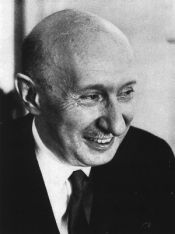






GEORG VON BÉKÉSY
 Georg von Békésy was born in Budapest, Hungary, on June
3,1899, the son of Alexander von Békésy, a diplomat, and his
wife, Paula. He received his early education in Munich, Constantinople,
Budapest, and in a private school in Zurich. Having passed the Swiss «Maturitätsprüfung»
he studied chemistry at the University of Berne. After a short military
service he received his Ph.D. in Physics in 1923 from the University of
Budapest. Later on he entered the services of the Hungarian Post Office
in Budapest where he stayed until 1946. He worked one year at the Central
Laboratory of Siemens and Halske A.G. in Berlin, at that time one of the
centers in the development of telecommunication. During vacations he spent
his free time in different workshops learning how to use a file for many
hours without hurting the hands.
Georg von Békésy was born in Budapest, Hungary, on June
3,1899, the son of Alexander von Békésy, a diplomat, and his
wife, Paula. He received his early education in Munich, Constantinople,
Budapest, and in a private school in Zurich. Having passed the Swiss «Maturitätsprüfung»
he studied chemistry at the University of Berne. After a short military
service he received his Ph.D. in Physics in 1923 from the University of
Budapest. Later on he entered the services of the Hungarian Post Office
in Budapest where he stayed until 1946. He worked one year at the Central
Laboratory of Siemens and Halske A.G. in Berlin, at that time one of the
centers in the development of telecommunication. During vacations he spent
his free time in different workshops learning how to use a file for many
hours without hurting the hands.
His work in the research laboratory of the Hungarian Post Offce was concerned
mainly with problems of long-distance telephone transmission. The friendly
and efficient atmosphere of this laboratory made it possible for him to
spend considerable time in the study of the ear as a main component of the
transmission system. Soon he became a nuisance to the autopsy rooms of the
hospitals and the mechanical workshops of the Post Office. There they did
not like to find their drill press full of human-bone dust in the morning.
But the wonderful laboratory spirit helped to overcome all difficulties,
except those produced by the destructions of World War II.
During the years 1939-1946 he was also Professor of Experimental Physics
at the University of Budapest. He left Hungary in 1946 for Sweden, where
he was a guest of the Karolinska Institute and did research at the Technical
Institute in Stockholm. It was during this period that he developed a new
type of audiometer which is operated by the patient and has applications
outside the field of hearing. For instance, it has permitted the determination
of the change in sensitivity of the eye of pigeons during dark adaptation.
In 1947 he went to the United States and has worked since then at Harvard
University in the Psycho-Acoustic Laboratory. Lately he has been interested
in developing a mechanical model of the inner ear with nerve supply, the
nerve supply being represented by the skin of the arm. This model shows
such close similarity to phenomena in hearing that it has become a useful
tool in the investigation of some specific problems that have been pursued
for many years.
His honours include the Denker Prize in Otology (1931), the Guyot Prize
for Speech and Otology of Groningen University (1939) and the Shambaugh
Prize in Otology (1950). He was the recipient of the Leibnitz Medal of the
Berlin Academy of Sciences (1937), the Academy Award of the Budapest Academy
of Science (1946), the Howard Crosby Warren Medal of the Society of Experimental
Psychologists (1955), and the Gold Medals of the American Otological Society
(1957) and the Acoustical Society of America (1961). Honorary doctorates
(M.D.) were conferred on him by the Universities of Munster (1955) and Berne
(1959).
From Nobel Lectures , Physiology or Medicine 1942-1962.
This page is located originally at http://www.nobel.se/laureates/medicine-1961-1-bio.html

 Georg von Békésy was born in Budapest, Hungary, on June
3,1899, the son of Alexander von Békésy, a diplomat, and his
wife, Paula. He received his early education in Munich, Constantinople,
Budapest, and in a private school in Zurich. Having passed the Swiss «Maturitätsprüfung»
he studied chemistry at the University of Berne. After a short military
service he received his Ph.D. in Physics in 1923 from the University of
Budapest. Later on he entered the services of the Hungarian Post Office
in Budapest where he stayed until 1946. He worked one year at the Central
Laboratory of Siemens and Halske A.G. in Berlin, at that time one of the
centers in the development of telecommunication. During vacations he spent
his free time in different workshops learning how to use a file for many
hours without hurting the hands.
Georg von Békésy was born in Budapest, Hungary, on June
3,1899, the son of Alexander von Békésy, a diplomat, and his
wife, Paula. He received his early education in Munich, Constantinople,
Budapest, and in a private school in Zurich. Having passed the Swiss «Maturitätsprüfung»
he studied chemistry at the University of Berne. After a short military
service he received his Ph.D. in Physics in 1923 from the University of
Budapest. Later on he entered the services of the Hungarian Post Office
in Budapest where he stayed until 1946. He worked one year at the Central
Laboratory of Siemens and Halske A.G. in Berlin, at that time one of the
centers in the development of telecommunication. During vacations he spent
his free time in different workshops learning how to use a file for many
hours without hurting the hands.